Roti is a whole wheat flatbread that's a staple in most Indian homes. Also known as Chapati or Phulka, this popular Indian bread is enjoyed with lentils, curries and stir-fries. Follow these tips and tricks, and learn how to make soft, puffy rotis every single time!
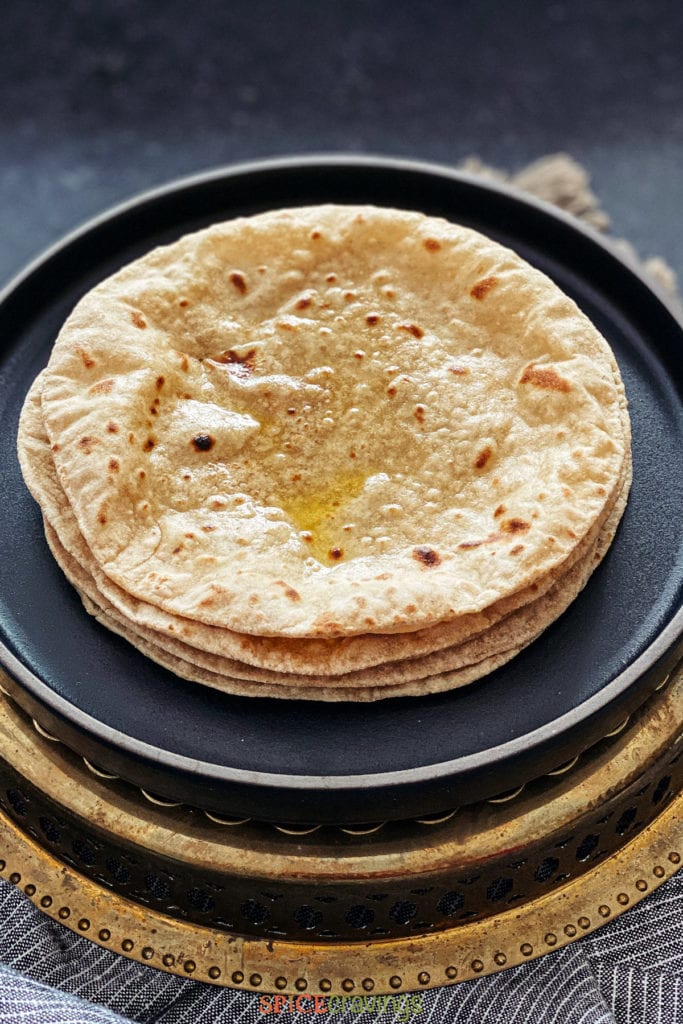
There's something about the smell of fresh puffed up rotis that transports me back to my mum's kitchen in seconds! It's a flatbread I grew up eating everyday.
Since roti is my kids' favorite accompaniment for Indian curries, I want them to learn the art and science behind making a fail-proof roti. With this recipe and a few tips and tricks that I've learned over the years, anyone can make and enjoy warm and puffy roti or phulka.
What is Roti?
Roti, also known as chapati or Phulka, is a circular flatbread from the Indian subcontinent made from stoneground whole-wheat flour (gehu). It's a staple in everyday Indian cooking.
A simple soft dough is prepared using water, then divided into smaller portions. Each dough ball is rolled into flat disc using a rolling pin called belan, on a flat surface called chakla. It is then cooked in a flat pan, called tawa.
Humble Origins of Roti: There are mixed stories when it comes to the origins of roti. Some citing suggest its existence in the Harappa Culture in Indus Valley Civilization 5000 years ago.
While other sources suggest that it was a staple food for the Swahili speaking people in East Africa, and it travelled to India via the trade route.
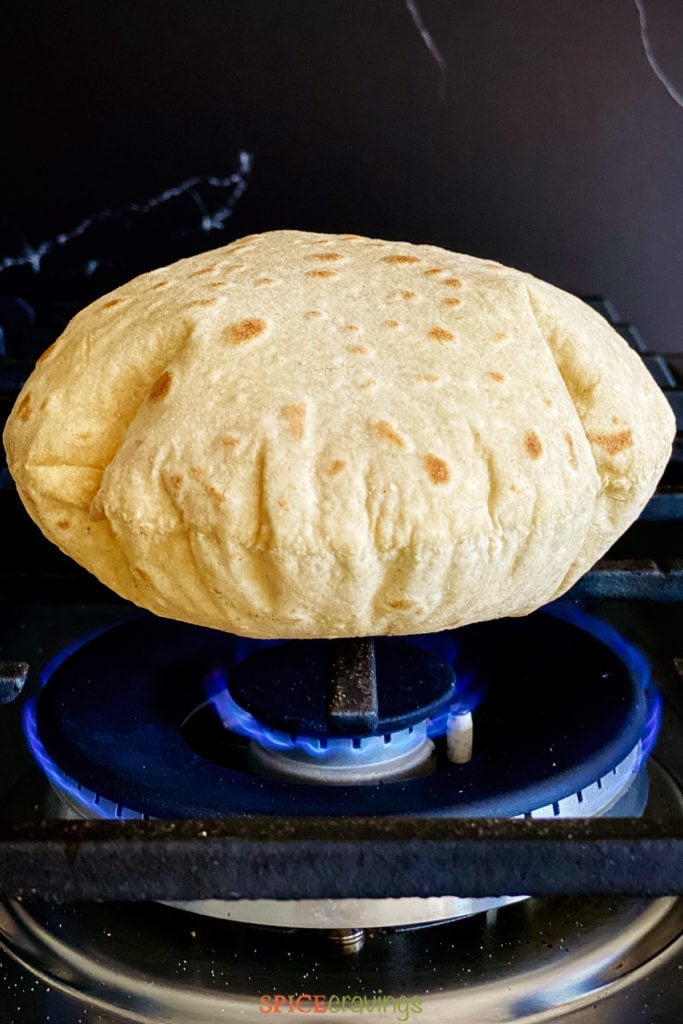
Difference between Roti, Phulka and Chapati
Roti, pronounced as row-tee, and Chapati, pronounced as chuh-paa-tee, are often used interchangeably, and refer to the same flatbread. After the dough is rolled out, it is then cooked on the tawa (or skillet), flipping multiple times until cooked all the way.
Phulka, pronounced as full-kaa, is cooked on one side till small air pockets form. Then you flip it and cook until air pockets form on this side. Now, using tongs you cook it over direct flame until the air pockets combine to make it puff up like a balloon.
You might also like another popular Indian Flatbread recipe for Naan.
What are the Ingredients of Roti?
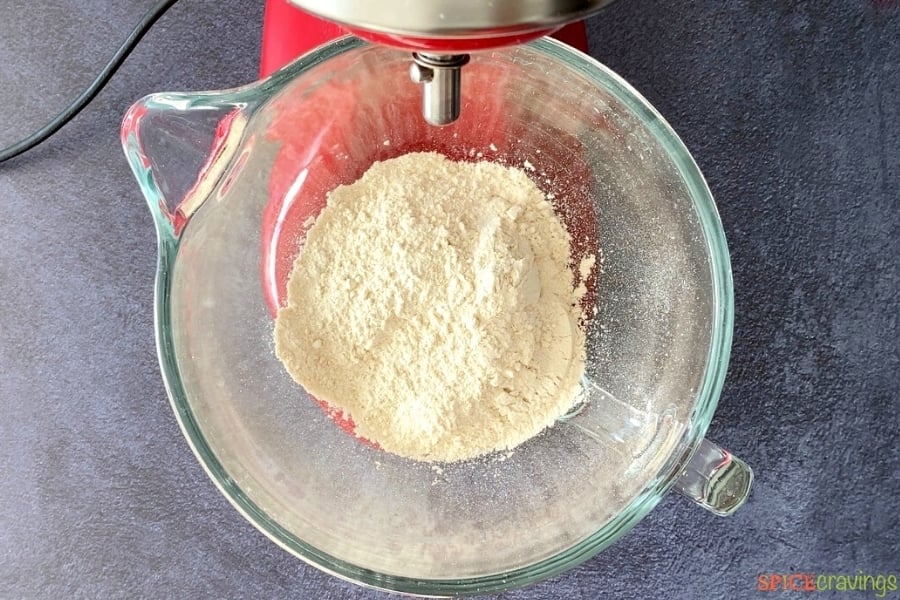
The main ingredient for making Roti is Atta, which is the Hindi word for whole wheat flour. In addition to that we need water, to knead the dough. These 2 ingredients are a staple in every Indian household.
- Atta (Flour): I like to use fine ground Whole wheat 'Chakki' atta to make roti. It is just the right consistency of flour to make these flatbreads. I have shared my preferred brands below.
- Water: Warm water is the secret to soft roti. The key is to keep it warm, not hot, not cold. I take regular water and pop it in the microwave for 15 to 20 seconds and that does the trick
- Ghee & Salt: These optional ingredients that add to the taste of roti and keep it soft for longer. I generally skip the salt, but add 1 teaspoon of ghee to knead the dough if I plan to use it over 2 days.
Which Flour is Best for Roti?
In the order of preference, I like Sujata Chakki Atta (Whole Wheat), Pillsbury Whole Wheat Chakki Atta, or Aashirvaad Whole Wheat Atta.
In general I find that the Indian brands are better for roti. The rotis don't stay soft with the other whole wheat flour brands.
Accessories Needed to Make Roti
You'll need a rolling pin, any flat rolling surface, a non-stick pan and tongs to make roti. Here are my tried and tested accessories:
- Rolling Pin (also called Belan)
- Chakla (Rolling surface) or any flat cutting board
- Non-stick pan or tava
- Tongs
How to Keep Roti Soft for a long time?
Here are a few tips and tricks that will keep your rotis soft for longer:
- Add 1 teaspoon of ghee or oil to the dough while kneading. This adds some fat to the dough, which keeps rotis softer for longer.
- Knead the dough using warm water. To warm water, take water in a cup and microwave it for 15 to 20 seconds. The water should be warm to the touch, not hot.
- While making rotis keep the spare dough covered with a damp paper towel at all times to keep it moist.
- Another trick is to store them in a tortilla box or wrap them in aluminum foil as soon as they are made, since exposure to air dries them out.
- A final trick is to apply ½ teaspoon of ghee to each roti while stacking and storing.
How to Fix Roti Dough Consistency?
Sometimes, the dough turns out too hard or too sticky due to various factors involved. If you've read the tips above, chances are, it won't happen. But if it does, here's how to save your roti dough:
- Too hard: Add a few tablespoon of warm water and gently knead that into the dough.
- Too Sticky: Add a few tablespoons of dry atta (flour) and knead that in the dough. Add more if needed until you reach the right consistency.
How to Make Roti- Step by Step Instructions
Step 1: Make Roti Dough (by hand or stand-mixer)
How to Knead Roti Dough by Hand
- In a large mixing bowl, add flour and ¼ cup of water. Using your fingers, gently mix the dough until all the water is absorbed.
- Add another ¼ cup water and keep mixing until it starts to form the dough. Depending on the brand of your flour, you will need ¾ to 1 cup of water. In the end, the dough should be soft but not sticky.
- Using your fist and lower palm, knead the dough for 1 minute. Wet your hand to smooth the dough. Add the oil (if using) and knead for another 30 seconds.
- Cover it with a damp kitchen towel and rest for 15 minutes for the glutens to develop. After that, knead the dough once again.
How to Knead Roti Dough Using Stand Mixer
- Add the dough to the mixing bowl. Turn on the stand mixer with dough attachment on the lowest speed. Start adding water, ¼ cup at a time. After adding about ¾ cup water, the dough should start coming together, in about 3 minutes. If needed, stop and scrape the sides of the bowl.
- At this point, check to see the consistency of the dough. The dough should be soft and pliable such that, when pressed with your thumb it leaves an impression. It the dough feels firm, turn the mixer on and add the remaining water.
- Knead the dough for a minute on low speed. Optionally, you can add 1 teaspoon oil or ghee during this process.
- Turn the mixer off and cover the dough with a damp kitchen towel and rest for 15 minutes. After that, knead it again for 15 seconds.
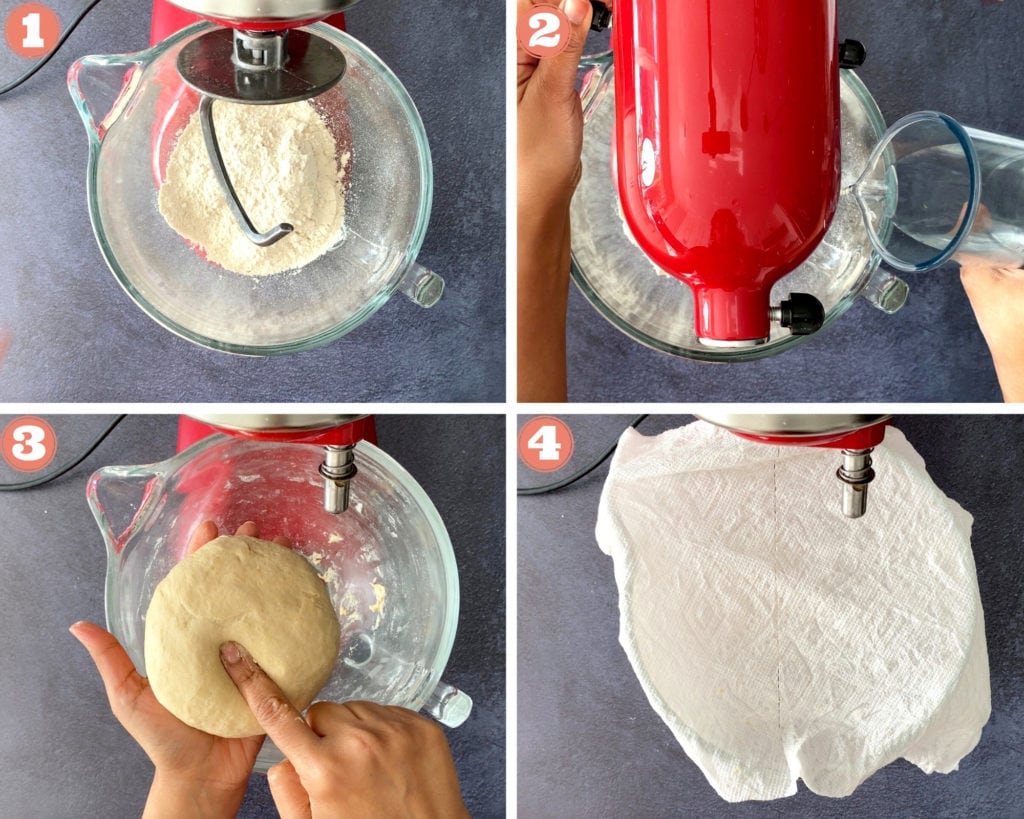
Step 2: Roll it out
- To make the roti, divide the dough into 12 equal portions, about the size of a lime and roll between your palms to make a smooth round ball without any cracks. Cover all dough balls with a damp towel.
- Put the other ¼ cup flour on a plate for dusting the dough while rolling. Ensure that your rolling pin and surface is dry.
- Take one dough ball at a time, while keeping the remaining dough covered with a damp towel so they don’t dry out. Dip the dough ball in the plate of dry flour, shake off the excess, then place it on a flat rolling surface, like a chakla, countertop, or a cutting board. Then flatten it gently by pressing with your fingers.
- Start rolling gently from the center in an outward motion, turning it about 45 degrees between each roll. Dust with flour in between to prevent sticking.
- Continue rolling until you flatten the dough into an even disc, about 7 inches in diameter. In the meantime, preheat a nonstick pan over medium-high heat.
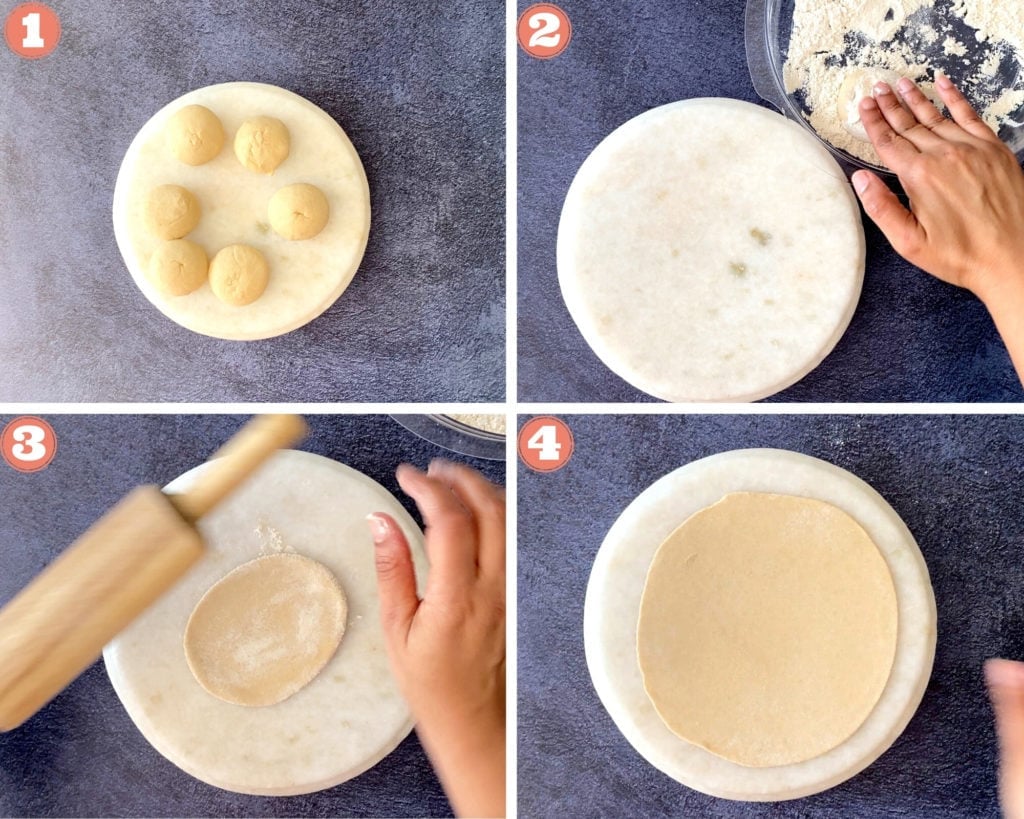
Step 3. Cook Roti (or Phulka)
- Dust off the excess flour from the rolled roti and place flat in the non-stick pan or tawa. Cook until small air pockets start forming on the surface, about 30 to 45 seconds.
- Using tongs, flip the roti. Cook until you see air pockets develop on this side, about 15 to 20 seconds, then flip again.
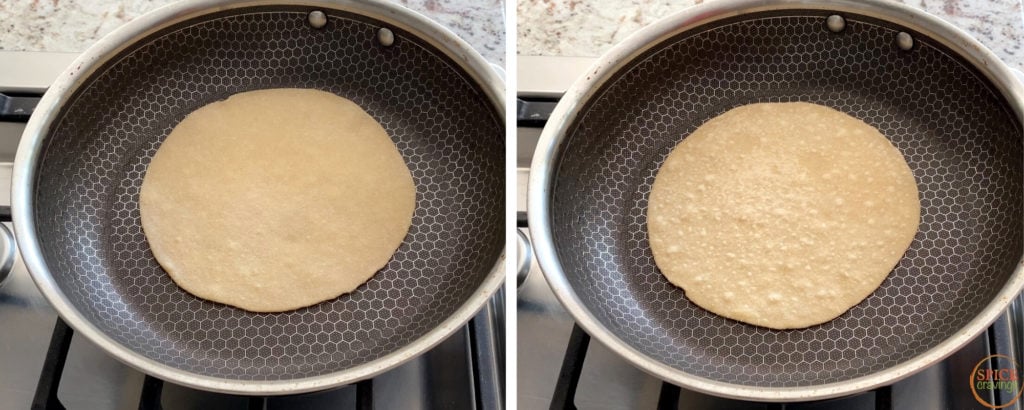
To Make Roti/ Chapati
- Using a flat spatula, gently press the roti while rotating it, until it begins to puff up. Flip it a few times to cook it evenly.
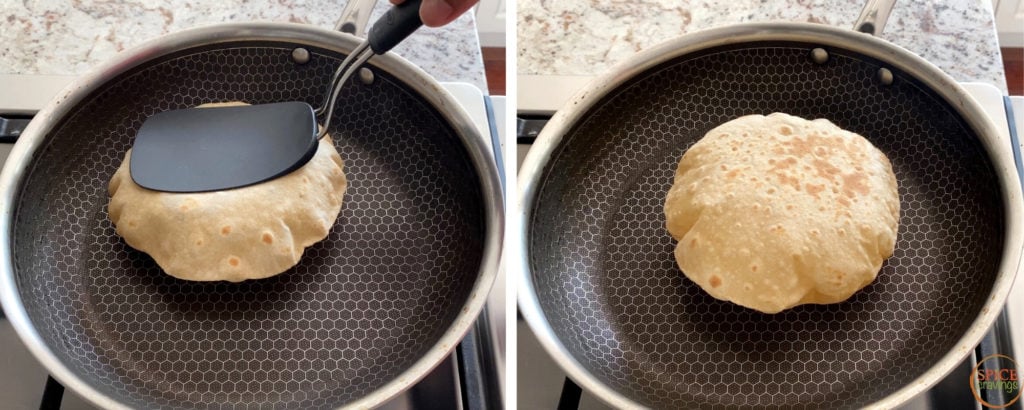
To Make Phulka
- Using tongs, lift the roti and move the pan on another burner. Reduce the heat to medium and cook the roti on direct flame until all the air pockets combine, making it puff up like a balloon.
- Rotate in between to prevent it from burning. Flip it a few times to cook it evenly.
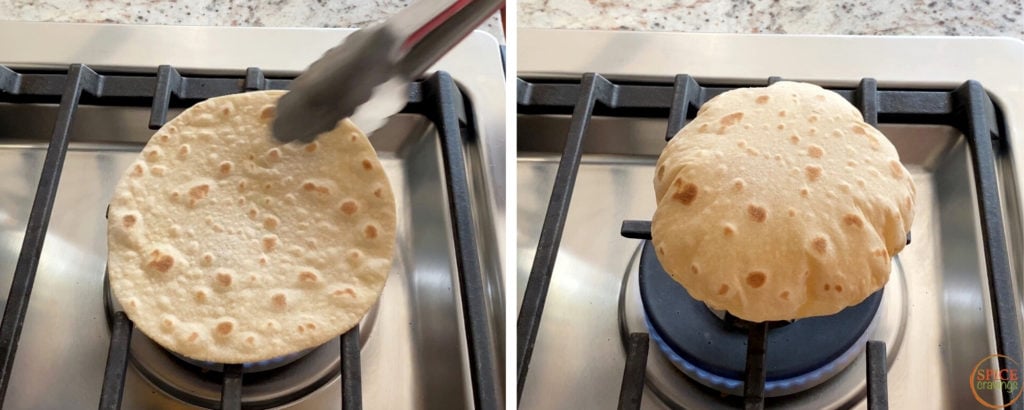
Serving & Storing Suggestion
How to Store Roti?
Remove cooked roti and store in a tortilla case lined with aluminum foil and a paper towel. The aluminum foil traps the heat and keeps them warm. The paper towel soaks any condensation and prevents them from turning soggy. Layer the rotis and store.
For storing leftover roti, tightly wrap them in aluminum foil layered with paper towel and refrigerate.
How to re-heat roti? Wrap the rotis in a damp paper towel and microwave for 30 seconds.
Serving Suggestion
Enjoy warm with your favorite dal, vegetable or curry. To enhance the flavor, spread ½ teaspoon ghee or olive oil before serving.
Pro Tips for Soft Rotis
- After kneading the dough, cover it with a damp cloth and rest it for 15 minutes to allow the glutens to develop. After that knead again for a quick 15 seconds before rolling.
- For softer rotis, knead the dough in warm water that has been microwaved for 15 to 20 seconds. Also, while making rotis keep the spare dough covered with a damp paper towel at all times.
- To ensure that the roti doesn't dry out while cooking, heat the pan on medium-high heat before you place it in.
- To get puffed up rotis, roll it out to an even thickness. Uneven thickness causes the dough to crack while cooking, causing it to deflate.
- The key to getting a round shaped roti is to rotate and roll. With practice, one learns to 'rotate while rolling', but that takes time. Perfecting the roti shape comes with practice, so don't be hard on yourself the first few times.
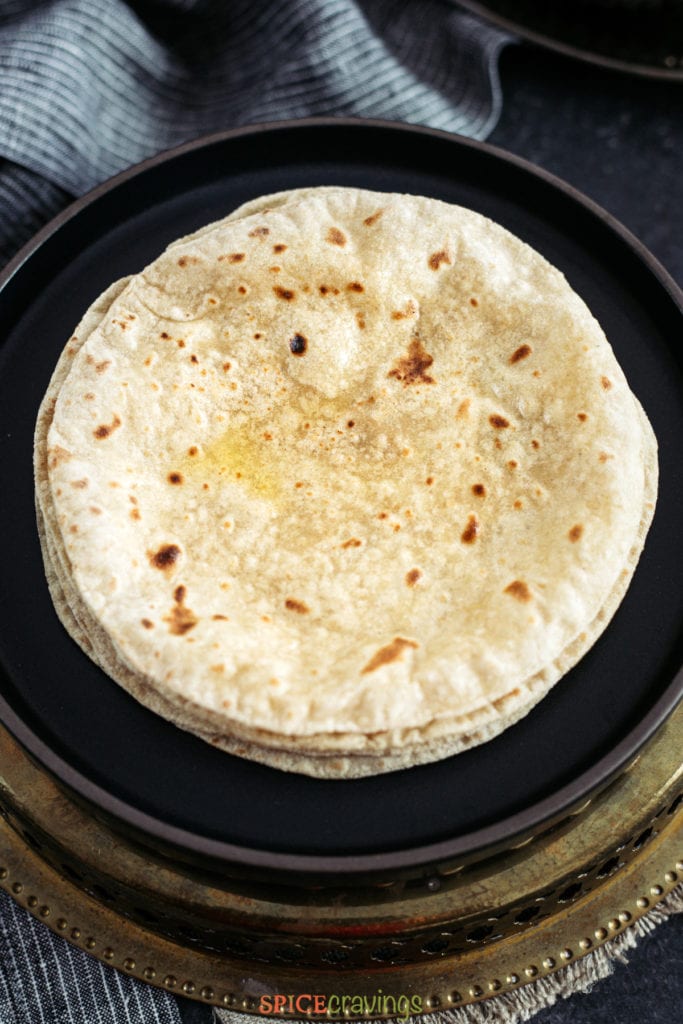
How to Store Roti Dough?
I store leftover Roti dough in an airtight container in the refrigerator for maximum 2 days. I find that after 2 days, the color of the dough begins to darken and taste changes.
Common Questions or Roti
Even though both are flatbreads cooked on the stove, the Spanish or Mexican Tortilla is made with all-purpose flour, oil, water and seasoning. Roti on the other hand, is mostly made with whole wheat flour and water. Occasionally, salt and ghee are added based on personal preference. One can say that Roti is like a whole wheat tortilla.
That's probably because your pan wasn't hot enough. For the roti to cook evenly and build up enough hot air to puff up, the pan has to be heated on medium-high heat before you place it in. Adding it to a cool pan, will dry it out while cooking and make it rubbery.
Making roti is like baking, it's a little bit of science combined with some practice. Few reasons why roti didn't puff up could be, that the pan wasn't hot enough, or the dough was too soft or too hard, or it wasn't rolled out to an even thickness. That being said, don't lose hope if your roti doesn't puff up the first time, read the tips section above and keep practicing.
Adding 1 teaspoon of ghee or oil to the dough while kneading adds some fat to the dough, which keeps them softer for longer. Also, knead the dough using warm water. Another trick is to store them in a tortilla box or wrap them in aluminum foil as soon as they are made, since exposure to air dries them out. A final trick is to apply ½ teaspoon of ghee to the roti while stacking and storing.
Yes. Since the roti dough is made with whole wheat flour and water, it is vegan. If you wish to add some kind of fat while kneading, use olive or canola oil to keep it vegan.
★ Did you make this recipe? Please give it a star rating below! For more quick & easy recipes, FOLLOW ME on Facebook, Instagram, Pinterest and Youtube.
📖 Recipe
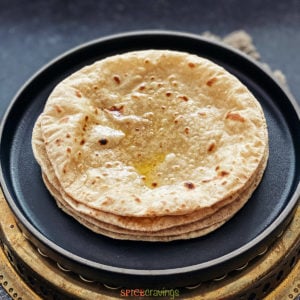
Roti Recipe- How to Make Roti (Chapati)
Equipment
Ingredients
- 2 cups whole wheat flour plus ¼ cup for dusting while rolling
- ¾-1 cup warm water or as needed (microwaved 15-20 seconds)
- 1 teaspoon olive oiI or ghee optional
Instructions
Knead Dough Using hands
- In a large mixing bowl, add flour and ¼ cup of water. Using your fingers, gently mix the dough until all the water is absorbed.
- Add another ¼ cup water and keep mixing until it starts to form the dough. Depending on the brand of your flour, you will need ¾ to 1 cup of water. In the end, the dough should be soft but not sticky.
- Using your fist and lower palm, knead the dough for 1 minute. Wet your hand to smooth the dough. Add the oil (if using) and knead for another 30 seconds.
- Cover it with a damp kitchen towel and rest for 15 minutes for the glutens to develop. After that, knead the dough once again.
Knead Dough Using Stand Mixer
- Add the dough to the mixing bowl. Turn on the stand mixer with dough attachment on the lowest speed. Start adding water, ¼ cup at a time. After adding about ¾ cup water, the dough should start coming together, in about 3 minutes. If needed, stop and scrape the sides of the bowl.
- At this point, check to see the consistency of the dough. The dough should be soft and pliable such that, when pressed with your thumb it leaves an impression. It the dough feels firm, turn the mixer on and add the remaining water.
- Knead the dough for a minute on low speed. Optionally, you can add 1 teaspoon oil or ghee during this process.
- Turn the mixer off and cover the dough with a damp kitchen towel and rest for 15 minutes. After that, knead it again for 15 seconds.
Roll it out
- To make the roti, divide the dough into 12 equal portions, about the size of a lime and roll between your palms to make a smooth round ball without any cracks. Cover all dough balls with a damp towel.
- Put the other ¼ cup flour on a plate for dusting the dough while rolling. Ensure that your rolling pin and surface is dry.
- Take one dough ball at a time, while keeping the remaining dough covered with a damp towel so they don’t dry out. Dip the dough ball in the plate of dry flour, shake off the excess, then place it on a flat surface and flatten it gently by pressing with your fingers.
- Start rolling gently from the center in an outward motion, turning it about 45 degrees between each roll. Dust with flour in between to prevent sticking.
- Continue rolling until you flatten the dough into an even disc, about 7 inches in diameter. In the meantime, preheat a nonstick pan over medium-high heat.
Cook Roti (or Phulka)
- Dust off the excess flour from the rolled roti and place flat in the pan or tawa. Cook until small air pockets start forming on the surface, about 30 to 45 seconds.
- Using tongs, flip the roti. Cook until you see air pockets develop on this side, about 15 to 20 seconds, then flip again.
To Make Roti
- Using a flat spatula, gently press the roti while rotating it, until it begins to puff up. Flip it a few times to cook it evenly.
To Make Phulka
- Using tongs, lift the roti and move the pan on another burner. Reduce the heat to medium and cook the roti on direct flame until all the air pockets combine, making it puff up like a balloon. Rotate in between to prevent it from burning. Flip it a few times to cook it evenly.
Serve Warm
- Remove cooked roti and store in a tortilla case or wrap it in aluminum foil. Repeat the process for other rotis. Enjoy warm with your favorite curry. To enhance the flavor, spread ½ teaspoon ghee or olive oil before serving.
Video
Notes
- After kneading the dough, cover it with a damp cloth and rest it for 15 minutes to allow the glutens to develop. After that knead again for a quick 15 seconds before rolling.
- For softer rotis, knead the dough in warm water that has been microwaved for 15 to 20 seconds. Also, while making rotis keep the spare dough covered with a damp paper towel at all times.
- To ensure that the roti doesn't dry out while cooking, heat the pan on medium-high heat before you place it in.
- To get puffed up rotis, roll it out to an even thickness so it can puff up. Uneven thickness causes the dough to crack while cooking, causing it to deflate.


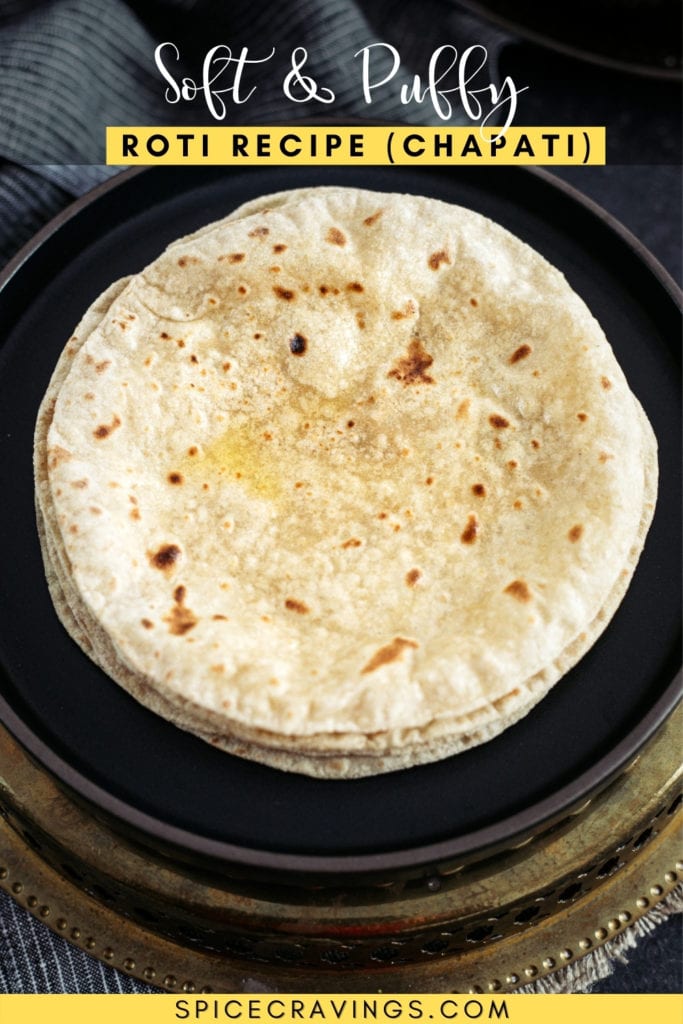
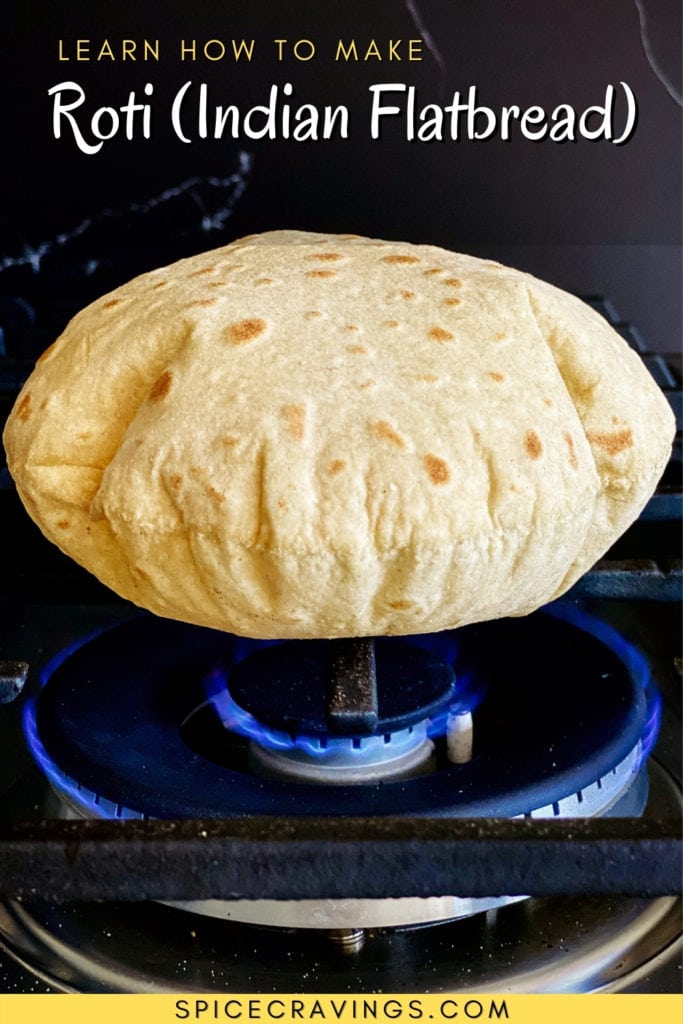
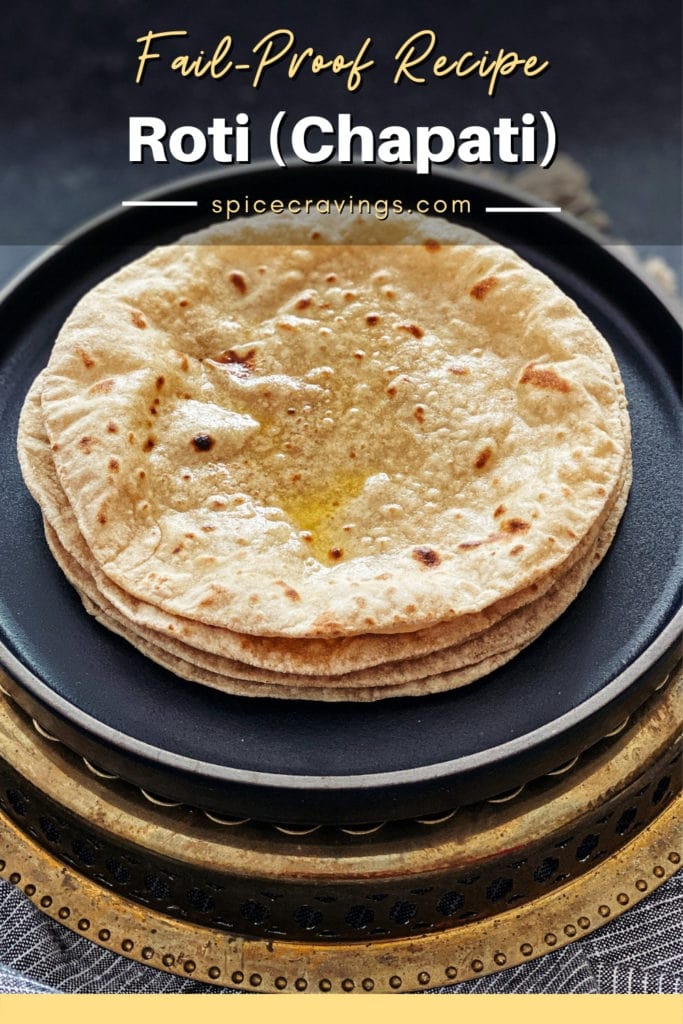
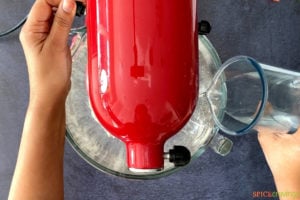
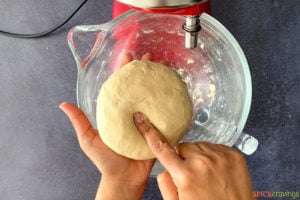
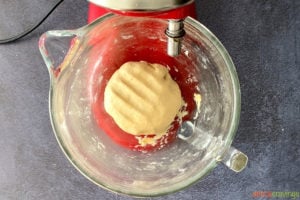
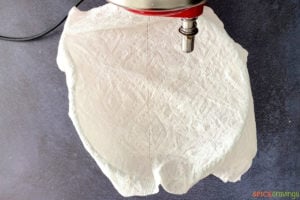
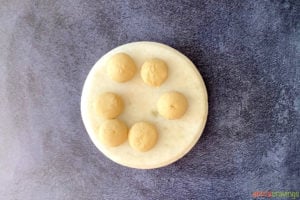
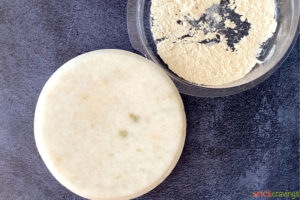
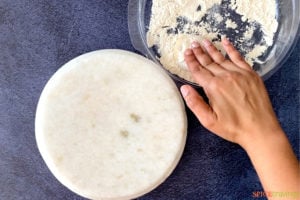
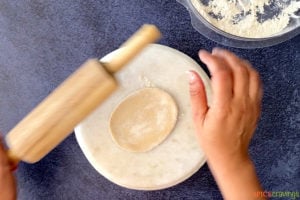
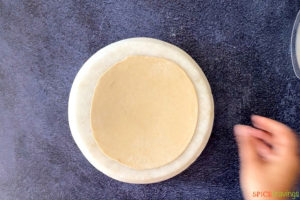
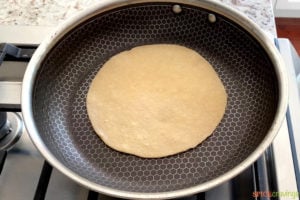
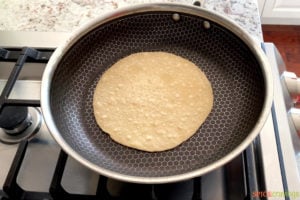
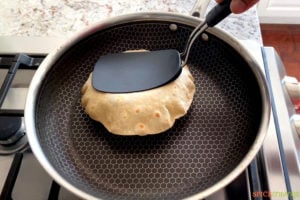
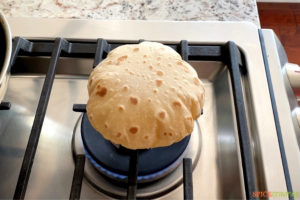
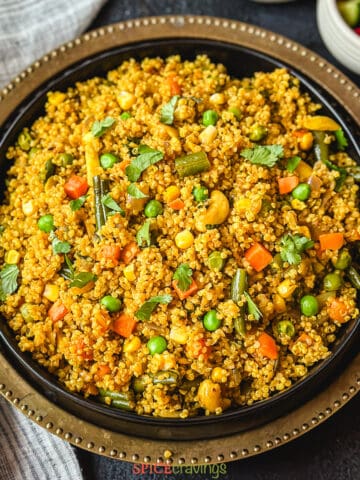
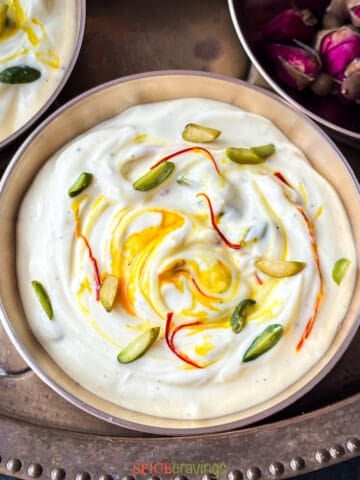
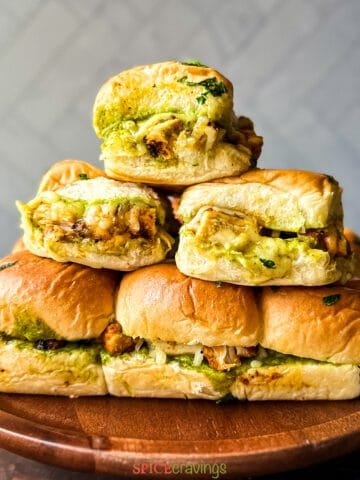
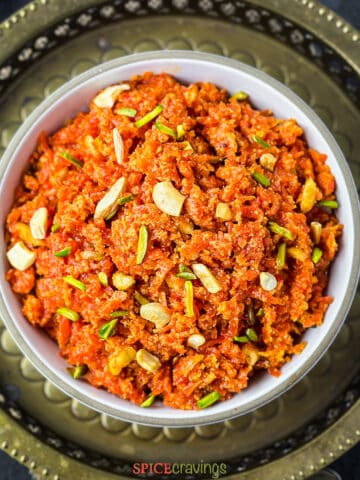

Toby says
Hi Aneesha - I have been making rotis for many years, more recently using my food processor [I do not have a stand mixer] but I was checking this morning to find out if people use bread making machines to do the kneading, and they do, and I have one. I wondered about at what point to add oil [which I want to add] and this is how your website came up. It is so well organized and thorough. I think you could include that in addition to using a stand mixer, a processor or a bread machine could also work. I can see how a stand mixer and a bread machine might be better for developing gluten with the lengthy kneading and ensuring a more consistent puffing. I am going to start using my bread machine to do the kneading.
Aneesha says
Hi Toby, thank you for the kind words, I really appreciate it! As for the bread machine, I personally haven't used it so can't really recommend it. I have used a food processor for making dough and find the stand mixer to be better. Like you mentioned, it kneads the dough better.
Dhanya says
Hi Aneesha,
Thank you very much for these instructions and tips...I feel less intimidated to try this .. I am going to try kneading by hand...Wish me luck! Will let u know. 😊
Aneesha says
Best of luck Dhanya! Feel free to reach out on Insta DM if you run into any trouble.
Jane says
Thank you for such detailed instructions Aneesha. I followed them and made my first puffy phulka!
Aneesha says
Hi Jane, I'm so happy you found the instructions to be useful. Nothing like a freshly cooked phulka to complete the meal 🙂